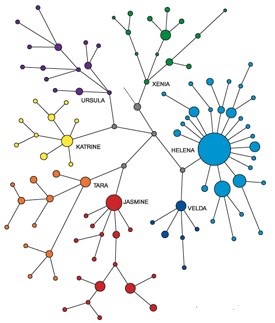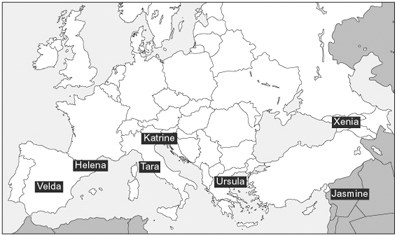Tajemství původu mateřské linie každého člověka je ukryté v jeho mitochondriální DNA nebo také mtDNA. Každý muž i každá žena vlastní tuto část DNA, ale pouze ženy ji mohou předat svým dětem.
Každý člověk dědí svou mtDNA po matce, nikdy od otce. Matka kohokoliv z nás ji zdědila od své matky, a ta zase od své, a tak dál do minulosti, až k pramatce celé mateřské linie. Mitochondriální DNA proto nese informace starší než jakýkoliv psaný záznam vytvořený člověkem. Genetická genealogie je aplikace genetiky k tradiční genealogii. Genetická genealogie zahrnuje použití genetických testů DNA pro stanovení úrovně a typu genetického vztahu mezi jednotlivci.
Sedm dcer Eviných je název knihy Bryana Sykese, která popularizuje teorii lidské mitochondriální genetiky. Sykes popisuje principy genetiky a lidské evoluce, specifika mitochondriální genetiky a analyzuje pravěkou DNA ve snaze najít pojítko mezi moderním člověkem a jeho dávnými předky.
Název knihy vychází z jednoho z výsledků mitochondriální genetiky, jímž je roztřídění 99% současných Evropanů do 7 skupin, tzv. mitochondriálních haploskupin. Každá haploskupina je definována sadou charakteristických mutací mitochondriální DNA (mtDNA) a lze ji stopovat po mateřské linii zpětně až ke specifické pravěké ženě. Tato mtDNA je přenášena z matky na potomstvo beze změn. Sykes hovoří o takových ženách jako o „matkách klanu“. Tyto ženy nežily současně a některé z nich jsou pravděpodobně potomky jiných, avšak nikoliv v mateřské linii. Všechny tyto ženy však sdílely v mateřské linii společného předka, tzv. mitochondriální Evu.
Sedmi „matkám klanů“ zmiňovaných Sykesem odpovídají následující haploskupiny:
- Uršula: odpovídá haploskupině U (bez podskupiny K) - latinsky "medvědice"
- Xénie: odpovídá haploskupině X - z řečtiny "pohostinná"
- Helena: odpovídá haploskupině H - z řečtiny "dcera světla"
- Velda: odpovídá haploskupině V - skandinávsky "vladařka"
- Tara: odpovídá haploskupině T – z gaelštiny "skála"
- Kateřina: odpovídá haploskupině K - z řečtiny "čistá"
- Jasmína: odpovídá haploskupině J - persky "květina"

Obrázek znázorňuje míru příbuznosti sedmi dcer Eviných. Každý z kroužků znázorňuje jednu mitochondriální sekvenci a jeho plocha je úměrná počtu lidí, kteří ji sdílejí. Čím je kroužek větší, tím více lidí danou sekvenci nese. Haploskupina H je tedy nejrozšířenější evropskou mitochondriální haploskupinou. V současné době náleží do této haploskupiny přibližně 40 % evropských mateřských linií. Spojující čáry představují mutace mitochondriální DNA. Čím je určitá čára delší, tím více mutací od sebe dané dvě sekvence odděluje.
Mnoho příslušníků evropských královských rodin má haploskupinu H. Mimo jiné je nositelkou této haploskupiny i naše geodcera a samozřejmě všichni její předci v mateřské linii (geomanželka, geotchýně ...................... Helena). Stáří celé haploskupiny je odhadováno na 25 tisíc let, kdy začala její expanze v rámci evropských populací. Vznik haploskupiny je geograficky kladen do oblasti jihozápadní Francie (viz obrázek níže), odkud její nositelé poměrně rovnoměrně osídlili celou Evropu. Dnes je nejvyšší výskyt této haploskupiny v jižní Francii a severním Španělsku.

Já jsem po svých předcích v mateřské linii nositelem haploskupiny T, stejně jako byl například poslední ruský car Mikuláš II. Příslušnost k této haploskupině byla zjištěna při identifikaci jeho ostatků. Pokud nejsou jeho rodokmeny zavádějící, lze za nositele haploskupiny T považovat i všechny potomky jeho nejstaršího předka v mateřské linii, Barbory Cellské (1390-1451), druhé ženy Zikmunda Lucemburského. Sem patří velké množství evropské šlechty, jako např. Jiří I. a Fridrich Vilém I. (přes Sofii Hanoverskou), Karel I. Stuart, Jiří III., Jiří V., Karel X. Gustav, Gustav II. Adolf, Mořic Oranžský, Olaf V. Norský a Jiří I. Řecký.
Nositelé haploskupiny T jsou rozšířeni zejména v jižní a západní Evropě. Nejčastěji se pak vyskytují v Irsku a na západě Británie. Stáří této haploskupiny je odhadováno na 17 tisíc let a její kořeny jsou situovány na území dnešní severozápadní Itálie v údolí řeky Arno (viz obrázek výše).
O velikostech jednotlivých haploskupin u nás může vypovídat i skutečnost, že jsem v České národní genografické databázi pro svou geomanželku patřící do haplosklupiny H našel několik genetických příbuzných různé úrovně. Pro mne patřícího po matce do haploskupiny T se zatím v této databázi nikdo nenašel. Pokud tedy znáte svou „matku klanu“, prosím o její uvedení v logu. Číslo, které uvidíte u kešky budete potřebovat k odlovu kešky GCFN2X - Adamova kletba, která se zabývá analýzou DNA v otcovské linií.
Cache najdete na souřadnicích: N 49°17.(J-T)(J-K)(X-U) E 017°25.(H-J-T)(X+V-U)(K-V)
Zdroje :
- Bryan Sykes, Sedm dcer Eviných; Paseka 2004
- Internetová encyklopedie Wikipedia
- Rodinné stránky s rodokmenem ownera na serveru WWW.MyHeritage.com s analýzou DNA od společnosti GENOMAC

The mystery of everyone’s maternal line is hidden in their mitochondrial DNA, or mtDNA. Every male and female have this DNA, but only females can pass it on to their children.
Every person inherits their mtDNA from their mother, never from their father. Each of our mothers inherited it from her mother, and she from her mother, and so on into the past, up until the great grandmother of the entire maternal line. Mitochondrial DNA therefore carries information older than any written record made by man. Genetic genealogy is the application of genetics to traditional genealogy. Genetic genealogy involves the use of genealogical DNA testing to determine the level and type of the genetic relationship between individuals.
The Seven Daughters of Eve is a name book by Bryan Sykes that presents the theory of Human mitochondrial genetics to a general audience. Sykes explains the principles of genetics and human evolution, the particularities of mitochondrial genetics, and analyses of ancient DNA to genetically link modern humans to prehistoric ancestors.
The title of the book comes from one of the principal achievements of mitochondrial genetics, which is the classification of 99% modern Europeans into 7 groups, the mitochondrial haplogroups. Each haplogroup is defined by set of characteristic mutations on the mitochondrial genome (MtDNA), and can be traced along a person's maternal line to a specific prehistoric woman. MtDNA is passed down by the mother unchanged, to all children. Sykes refers to these women as "clan mothers", though these women did not all live concurrently, and indeed some "clan mothers" are descended from others (although not maternally). All these women in turn shared a common maternal ancestor, the Mitochondrial Eve.
The seven "clan mothers" mentioned by Sykes each corresponds to one (or more) human mitochondrial haplogroups:
- Ursula: corresponds to Haplogroup U (excluding its subgroup K) – from the Latin "Female bear"
- Xenia: corresponds to Haplogroup X - from the Greek "Hospitable"
- Helena: corresponds to Haplogroup H - from the Greek "Daughter of Light"
- Velda: corresponds to Haplogroup V - from the Scandinavian "Female monarch"
- Tara: corresponds to Haplogroup T - from the Gaelic "Rock"
- Katrine: corresponds to Haplogroup K - from the Greek "Clean"
- Jasmine: corresponds to Haplogroup J – from the Persian "Flower"

The picture shows the degree of relatedness of seven daughters of Eve. Each ring represents one mitochondrial sequence and its area is proportional to the number of people who share it. The ring is greater, the more people the sequence carries. Haplogroup H is the most expansive of the European mitochondrial haplogroups, 40 % of European maternal lines presently belong to this haplogroup. The connecting lines represent mutations of mitochondrial DNA. What is certain line longer, the more mutations from each of the two sequences are separated.
Many European royals have been found to be of this mtDNA Haplogroup, in addition to Haplogroup H (mtDNA). Among other things, the bearer of this haplogroup is our geodaughter and all her relatives in the maternal line (geowife, geomother-in-law ...................... Helena). Age entire haplogroup H is estimated at 25 thousand years, when it began its expansion in the European populations. The emergence of haplogroup H is geographically placed in Southwestern France, where its bearers relatively evenly colonized the whole of Europe (see picture below). The highest incidence of this haplogroup of nowadays is in Southern France and Northern Spain.

I am a bearer of haplogroup T after my ancestors in the maternal line, as well as the last Russian Tsar Nicholas II. Assuming all relevant pedigrees are correct, this includes all female-line descendants of his female line ancestor Barbara of Celje (1390-1451), second wife of Sigismund, Holy Roman Emperor. This includes a great number of European nobles, including George I of Great Britain and Frederick William I of Prussia (through the Electress Sophia of Hanover), Charles I of England, George III of the United Kingdom, George V of the United Kingdom, Charles X Gustav of Sweden, Gustavus Adolphus of Sweden, Maurice of Nassau, Prince of Orange, Olav V of Norway, and George I of Greece.
Carriers of haplogroup T are particularly widespread in Southern and Western Europe. Most often it occurs in the west of Ireland and Britain. Age of this haplogroup is estimated to be 17,000 years old and its roots are situated on the territory of today's Northwestern Italy, in the valley of the river Arno (see picture above).
About the size of haplogroups in the Czech Republic may reflect the fact that I was in The Czech National Genographic database for my geo wife belonging to haplogroup H found several different levels of genetic relatives. For me belonging to the mother haplogroup T in the database have never been found. If you know your "clan mothers", please bring it into the log. The number that you see in the cache, you will need to catch the cache GCFN2X - Adam's curse, which analyzes DNA in the paternal line.
Cache can be found at coordinates: N 49°17.(J-T)(J-K)(X-U) E 017°25.(H-J-T)(X+V-U)(K-V)
Sources :
- Bryan Sykes, The Seven Daughters of Eve; Bantam Press 2001
- Internet Encyclopedia WWW.wikipedia.org
- Family website with pedigree owner of the server WWW.MyHeritage.com with the analysis of DNA from company GENOMAC